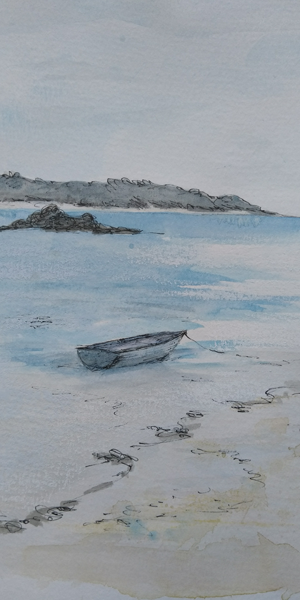There are more than two hundred scheduled monuments on the Isles of Scilly. They include a maze on St Agnes, a deer park wall on Samson, kelp pits on St Mary’s, a quarantine hospital on St Helen’s, Second World War pillboxes on St Mary’s and early Christian churches on Tean and St Helen’s. But the most scheduled sites are prehistoric or Romano-British.
The first human inhabitants of what was then the single island of Ennor (as Scilly was then) were late Neolithic (stone age) nomadic hunter-gatherers. Their flint tools are still sometimes found on beaches and in fields.
Over eighty entrance graves have been found. They are circular, made of stone and earth, surrounded by a stone kerb, with a rectangular stone chamber beneath. Many face Easterly to catch the rays of the rising sun. Bronze Age graves are found at Bant’s Carn on St. Marv’s. and most famously on Samson (where one unusually consists of two chambers sharing a single cairn.) St. Helen’s. Tean and St. Martin’s have standing stones. The remains of early Christian chapels are found at Long Rock, St. Mary’s, the Old Man of Gugh and the Menhir on Chapel Down, St Martin’s.

On Bryher, a particularly important iron age burial was found in 1999. It was a north-south orientated chamber containing the remains of a crouched human skeleton. The individual (it has been impossible to determine the gender) was about 25 years old and was buried with a sword and bronze scabbard, a mirror, shield fittings, a sword belt ring, a brooch and a spiral ring, together with a broken tin object and the remains of a sheepskin or fleece. It is the only known Iron Age grave to contain both a sword and a mirror. Archaeologists date it to the first century BC, making the Bryher mirror the earliest British decorated bronze mirror.
The mirror and sword can be viewed in the Isles of Scilly Museum on St Mary’s which is well worth a visit. It also houses treasures from many of the wrecks on the islands.
The sword and mirror burial site is situated on Hillside Farm, towards the southern end of Bryher, just below the 10m contour line at the base of the north-facing slope of Samson Hill. The island has numerous other Bronze Age cairns and entrance graves, together with remains of prehistoric field systems and boulder walls of other fields in the intertidal zones. Other Iron Age and Roman remains also include the remaining walls of an Iron Age cliff castle on Shipman Head Down, and a stone-lined cist grave lying below the present high water mark in Green Bay.
